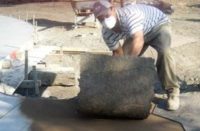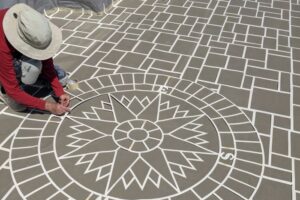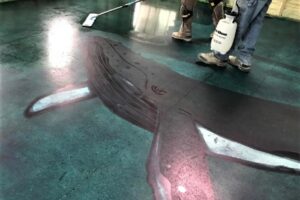 Stencils are generally made from either paper or plastic, and are cut with dies that stamp out the pattern in a consistent manner.
Stencils are generally made from either paper or plastic, and are cut with dies that stamp out the pattern in a consistent manner.
Paper stencils are usually thin pressed cardboard and are waxed, either on one or both sides, to resist moisture. Paper stencils come in rolls of varying sizes, such as 500 square feet and 1,000 square feet.
Plastic (or vinyl) stencils come in sheets, such as 4-by-5 or 4-by-8.
Plastic stencils do have advantages over paper, reports Jerry Atwater of Universal Templates Inc. in Pequot Lakes, Minn. “Plastic templates/ stencils have an advantage over cardboard because they will not delaminate when they get wet. Delamination causes a major problem on the job because the material has to be picked out of the joints.” Plastic stencils also are reusable, though he says “sometimes cleaning and storing them are just not worth the labor.”
Despite these advantages, plastic stencils may not be the best choice for new concrete applications.
Jeff Hartzog of Specialty Concrete Products Inc. in West Columbia, S.C., points out, “Plastic stencils are really designed for renovation work,” such as overlay or spray applications. “They are difficult to float in new concrete applications,” he reports, adding, “picking up and moving them is very difficult if not impossible [in new concrete].”
Another disadvantage to using plastic or vinyl stencils on fresh concrete is the cost, reports Greg Chapman, director of training and technical assistance at Elite Crete Systems Inc. in Merrillville, Ind. “When you stencil wet-pour concrete you need enough stencil to cover the whole pour.” If you have to have many sheets of plastic stencil for large pours it could get very costly. On the other hand, he says throw-away stencils — at, say, 23 cents per square foot — can be factored into the job.
The matter of cost also comes into play if you have areas in which you need to trim or cut the stencil. You wouldn’t necessarily want to do that with an expensive plastic stencil.
No matter what type stencil you use, be sure to take proper care of it.
Jim Mullins, director of training for Artcrete Inc. in Indianapolis, recommends, “Care should be taken not to get folds and crimps in the stencil during storage and transporting to the job site. This will affect how the stencils lay on the freshly poured concrete.”















